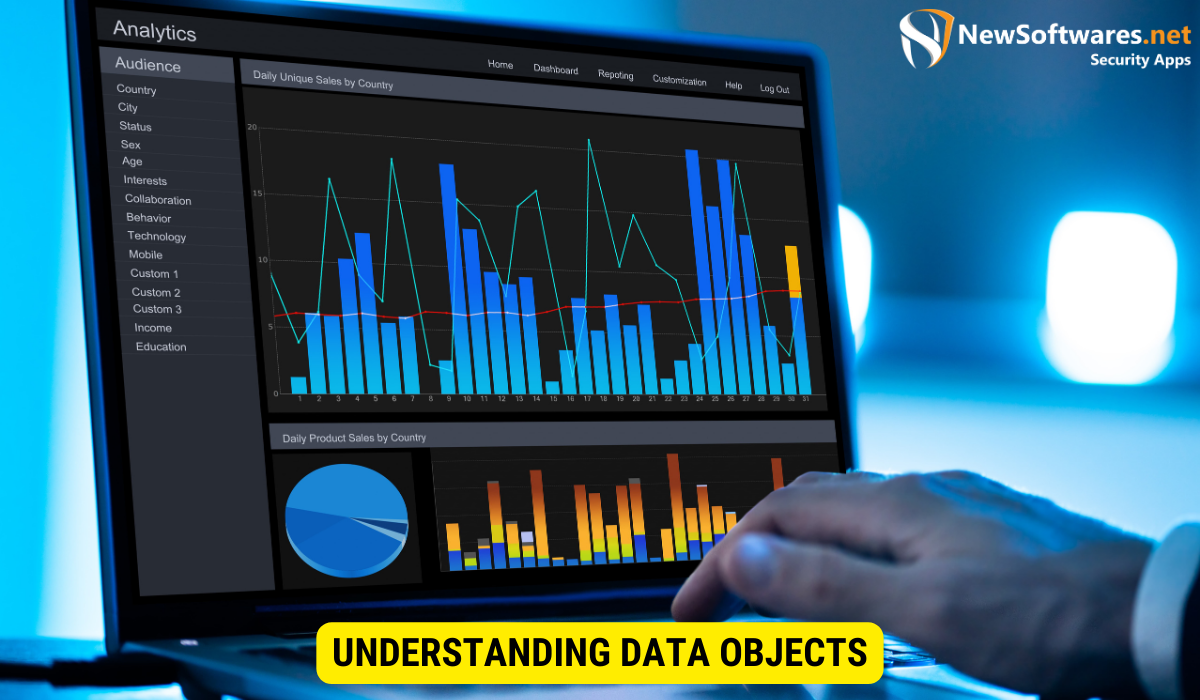Data objects are crucial in information security as they store, process, or transmit data. Their proper management ensures the confidentiality, integrity, and availability of information. Challenges in managing data objects include inconsistent access controls and inadequate data categorization. Overcoming these challenges involves implementing robust security measures, such as encryption and access controls, and adopting effective data management practices. Emerging technologies will further impact data object security, emphasizing the importance of advanced management solutions for future information security.
Data objects play a crucial role in information security, providing the foundation for protecting sensitive data and ensuring the confidentiality, integrity, and availability of information. Understanding the nature of data objects and their various types is essential for effectively managing and safeguarding valuable data assets.
Understanding Data Objects

Data objects can be defined as entities that store, process, or transmit data within an information system. They possess unique characteristics that differentiate them from other components of the system.
When it comes to understanding data objects, it is important to delve deeper into their definition and characteristics. Data objects are not just mere storage containers; they are physical or virtual entities that hold data and possess attributes such as data type, size, format, and access controls. These attributes play a crucial role in determining how the data objects can be utilized and manipulated within the system.
One of the key distinguishing factors of data objects is their ability to be structured or unstructured. Structured data objects, such as a table in a database, follow a specific format and organization, making it easier to search, retrieve, and analyze the data within them. On the other hand, unstructured data objects, like a plain text document, do not have a predefined structure and can contain information in various formats, making it more challenging to extract meaningful insights.
The Different Types of Data Objects
Data objects can be classified into various types based on their purpose and functionality. Let’s explore some of these types:
- Personal Data Objects: These include personal information stored in databases or files, such as names, addresses, or social security numbers. Personal data objects are subject to privacy regulations and require strict access controls to protect individuals’ sensitive information.
- Confidential Data Objects: These objects contain highly sensitive data, such as financial records, trade secrets, or classified information. Confidential data objects are often encrypted and restricted to authorized personnel to prevent unauthorized access and potential data breaches.
- System Data Objects: These objects are integral to the functioning of an information system. They include configuration files, system logs, or network settings. System data objects provide crucial information for system administrators to monitor and manage the system effectively.
- Application Data Objects: These objects are specific to an application and include user profiles, session data, or application-specific settings. Application data objects play a vital role in providing a personalized experience to users and ensuring the smooth operation of the application.
- Network Data Objects: These objects pertain to network infrastructure, such as routers, switches, firewalls, or intrusion detection systems. Network data objects are essential for network administrators to monitor and secure the network infrastructure, ensuring smooth data transmission and protecting against potential threats.
Understanding the different types of data objects is crucial for designing and implementing effective data management strategies. By recognizing the unique characteristics and functionalities of each type, organizations can ensure the proper handling, storage, and utilization of their data, ultimately leading to improved efficiency and decision-making.
The Role of Data Objects in Information Security
Data objects play a fundamental role in ensuring the security and protection of valuable information assets. They contribute to maintaining confidentiality, integrity, and availability of data.
When it comes to information security, confidentiality is a crucial aspect. Data objects enable the implementation of access controls, encryption, and other security measures to restrict unauthorized access and protect sensitive information.
Data objects can store confidential data in an encrypted format, ensuring that only authorized individuals or systems with the proper decryption keys can access and interpret the information. This encryption process involves converting the original data into an unreadable format, making it virtually impossible for unauthorized parties to decipher the information, even if they manage to gain access to it.
Moreover, data objects also support integrity checks. Data integrity ensures that information remains accurate, complete, and unaltered throughout its lifecycle. Organizations can employ mechanisms such as checksums or digital signatures to validate the integrity of data objects.
By validating the integrity of data objects, organizations can detect any unauthorized changes or data manipulation, thereby ensuring the reliability and trustworthiness of their information. These integrity checks act as a safeguard against data tampering, ensuring that the information remains intact and unaltered.
In addition to confidentiality and integrity, availability is another critical aspect of information security. Data objects contribute to availability by employing redundancy, backups, and disaster recovery strategies.
Organizations understand the importance of having continuous access to critical information. By implementing appropriate redundancy measures, organizations can minimize the risk of data loss and ensure the continuous availability of critical information, even in the event of hardware failures or natural disasters.
Redundancy involves creating multiple copies of data objects and storing them in different locations or systems. This redundancy ensures that if one system or location fails, there are backup copies available to maintain the availability of the data.
In addition to redundancy, organizations also implement backup and disaster recovery strategies. Regular backups of data objects are performed to ensure that in case of any data loss or system failure, the information can be restored from the backup copies.
Furthermore, disaster recovery strategies are put in place to handle catastrophic events such as natural disasters or cyber-attacks. These strategies involve creating off-site backups, establishing alternate data centers, and implementing procedures to quickly recover and restore data objects in case of a disaster.
In conclusion, data objects play a crucial role in information security by ensuring confidentiality, integrity, and availability of valuable information assets. By employing access controls, encryption, integrity checks, redundancy, backups, and disaster recovery strategies, organizations can protect their data from unauthorized access, tampering, and ensure continuous availability when needed.
The Importance of Data Objects in Information Security
Data objects are of paramount importance in information security. They not only provide the foundation for security measures but also enhance overall risk management strategies.
Enhancing Security Measures through Data Objects
Data objects enable the implementation of various security measures, such as access controls, encryption, and intrusion detection systems. These measures enhance the overall security posture of an organization by safeguarding sensitive information against unauthorized access, data breaches, or cyberattacks.
Through the proper utilization of data objects, organizations can establish comprehensive security frameworks that address potential risks and vulnerabilities.
The Impact of Data Objects on Risk Management
Risk management is an integral part of information security. Data objects facilitate risk management by providing a clear understanding of the data assets, their value, and the potential threats and vulnerabilities associated with them.
By accurately assessing risks and implementing appropriate controls on data objects, organizations can mitigate potential threats, minimize the impact of security incidents, and protect their information assets effectively.
Challenges in Managing Data Objects for Information Security
While data objects play a crucial role in information security, managing them effectively poses several challenges that organizations must overcome.
Common Pitfalls in Data Object Management
Organizations often face challenges in managing data objects due to factors such as inadequate data categorization, inconsistent access controls, or insufficient data governance frameworks.
Common pitfalls include improper data classification, lack of awareness about data sensitivity, or the absence of proper data retention and disposal policies.
Overcoming Obstacles in Data Object Security
To overcome challenges in data object security, organizations should adopt best practices such as implementing data classification schemes, developing robust access control mechanisms, and establishing clear data management policies.
Educating employees about data security best practices and providing regular training on data object management can also significantly enhance overall security measures.
Future Trends in Data Objects and Information Security

The field of information security is constantly evolving, and data objects are expected to play an even more significant role in the future.
Emerging Technologies and Their Impact on Data Objects
Technological advancements such as Internet of Things (IoT), artificial intelligence (AI), and blockchain are set to revolutionize the management and security of data objects.
These technologies will enable organizations to handle vast amounts of data, enhance real-time data monitoring and analysis capabilities, and implement robust security measures to protect data objects from emerging threats.
Predictions for Data Objects in Information Security
In the future, data objects are expected to become even more interconnected and intertwined with other components of information systems.
Organizations will focus on implementing advanced data object management solutions that provide seamless integration, enhanced security, and improved usability, thereby strengthening their overall information security posture.
Key Takeaways
- Data objects are essential components of information systems that store, process, or transmit data.
- Understanding the types and characteristics of data objects is crucial for effective information security management.
- Data objects play a significant role in ensuring confidentiality, integrity, and availability of information.
- Managing data objects effectively enhances security measures and contributes to overall risk management strategies.
- The future of data objects in information security lies in emerging technologies and advanced management solutions.
FAQs
What are data objects in information security?
Data objects are entities that store, process, or transmit data within an information system. They include files, databases, documents, or any form of digital or physical data storage.
How do data objects contribute to information security?
Data objects enable the implementation of security measures such as access controls, encryption, and redundancy to protect sensitive information from unauthorized access, data breaches, or cyberattacks.
What challenges are involved in managing data objects for information security?
Common challenges include inadequate data categorization, inconsistent access controls, lack of data governance frameworks, and improper data retention and disposal policies.
How can organizations enhance data object security?
Organizations can enhance data object security by implementing data classification schemes, robust access control mechanisms, clear data management policies, and providing regular training on data object management best practices.
What is the future of data objects in information security?
The future of data objects lies in emerging technologies like IoT, AI, and blockchain, which will revolutionize data object management, enhance real-time monitoring and analysis capabilities, and strengthen overall information security measures.
Conclusion
Data objects are fundamental components of information security, playing a critical role in protecting sensitive data and ensuring the confidentiality, integrity, and availability of information. Understanding the different types and characteristics of data objects is essential for effective security management. Through the implementation of security measures and the overcoming of challenges, organizations can enhance their overall security posture and effectively manage data objects to mitigate risks and protect valuable information assets.
